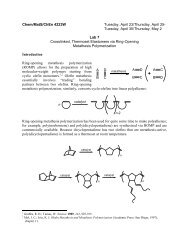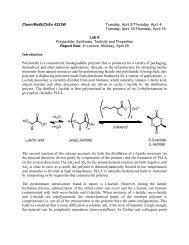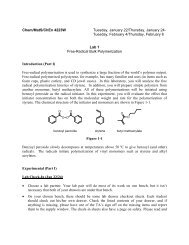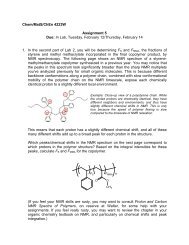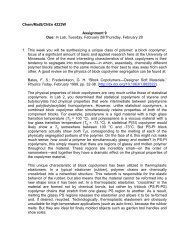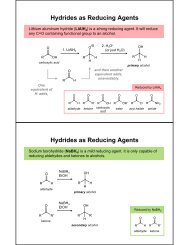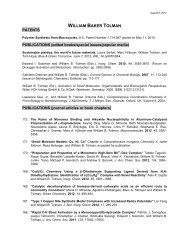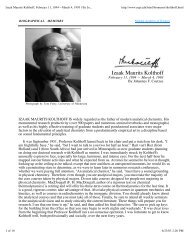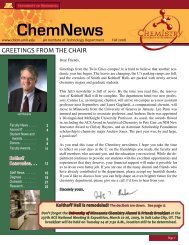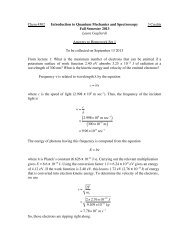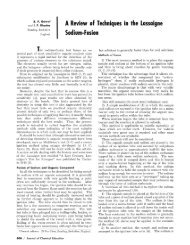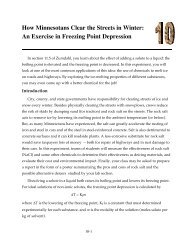Inverse Opal Photonic Crystals - Department of Chemistry ...
Inverse Opal Photonic Crystals - Department of Chemistry ...
Inverse Opal Photonic Crystals - Department of Chemistry ...
Create successful ePaper yourself
Turn your PDF publications into a flip-book with our unique Google optimized e-Paper software.
B. Sol-gel templating procedure<br />
1. Using Figure 13 as a guide, place a neoprene adapter in the neck <strong>of</strong> a filtering flask, and then<br />
insert a Büchner funnel. The adapter is used to create a sealed system when a vacuum is<br />
applied, so that liquids added to the Büchner funnel will be forced into the filtering flask.<br />
Connect one end <strong>of</strong> a rubber tube to the filter flask, and the other end to a vacuum line.<br />
2. Place a piece <strong>of</strong> weighing paper on a balance, zero it, and weigh out about 10 g <strong>of</strong> dry<br />
PMMA (roughly one pellet <strong>of</strong> PMMA). Place the PMMA pellet onto a paper towel, and<br />
using a metal spatula lightly crush the PMMA into a powder. Set this PMMA powder aside<br />
for later use.<br />
3. In a well-ventilated fume hood, place a small glass vial (20 mL) on an electric stir plate, and<br />
insert a magnetic stir bar. Turn on the stir plate so that the stir bar slowly rotates (if this<br />
shakes the vial, secure it in place with a three-finger clamp). Using a small graduated<br />
cylinder, measure out 4 mL <strong>of</strong> methanol (or preferably, ethanol). Add the methanol (or<br />
preferably, ethanol) to the glass reaction vial using a pipette. Measure out 6 mL <strong>of</strong> TMOS<br />
(or preferably, TEOS), using a pipette to transfer the liquid from the bottle to the graduated<br />
cylinder. Add the TMOS (or preferably, TEOS) to the glass vial using a pipette. The liquids<br />
will mix (if they aren’t mixing, turn up the stir rate a little). Now measure out 3 mL <strong>of</strong><br />
distilled, deionized water and add it to the glass vial in the same manner as above. Next,<br />
carefully measure out 1 mL <strong>of</strong> concentrated hydrochloric acid (HCl), using a pipette to<br />
transfer the HCl from the bottle to the graduated cylinder. (Caution: never try to pour<br />
concentrated acids from a bottle, they are extremely corrosive and will cause severe burns if<br />
they come in contact with skin or eyes. If HCl comes in contact with skin or eyes,<br />
immediately wash with large amounts <strong>of</strong> water.) Using a pipette, add the HCl dropwise to<br />
the reaction vial. Be careful, rapid addition <strong>of</strong> HCl will cause the mixture to boil.<br />
4. Turn on the vacuum line to a very low setting. Place a piece <strong>of</strong> filter paper in the Büchner<br />
funnel. Using a pipette, completely wet the filter paper with methanol (or preferably,<br />
ethanol). The filter paper should seal to the funnel. If the filter paper does not adhere, apply<br />
more methanol (or preferably, ethanol) and flatten the filter paper with a spatula. Pour the<br />
PMMA powder onto the filter paper in the Büchner funnel. Using a metal spatula, spread<br />
and lightly pack the PMMA so it evenly covers the entire filter paper (the powder should be<br />
less than a half centimeter thick; if a small Büchner funnel is used, you should use less<br />
PMMA).<br />
5. Turn the vacuum line on its highest setting (a low vacuum setting can lead to dense solids<br />
rather than porous ones). Using a pipette, carefully drip about 10 mL <strong>of</strong> the sol-gel solution<br />
prepared above (in step 3) over the entire surface <strong>of</strong> the PMMA, being careful to wet all <strong>of</strong><br />
the PMMA before running out <strong>of</strong> liquid. This can be a bit tricky. Slowly drip the liquid on<br />
the PMMA back-and-forth across the upper surface <strong>of</strong> the PMMA powder so that the entire<br />
surface is wetted uniformly. Only use leftover sol-gel liquid if the liquid coverage is not<br />
uniform, as the addition <strong>of</strong> too much liquid can lead to dense solids instead <strong>of</strong> porous solids.<br />
If not all <strong>of</strong> the PMMA is coated, it is not necessary to prepare any more sol-gel solution; the<br />
yield will simply be a bit smaller. Let the vacuum line continue to run on high for about 20<br />
minutes (this will speed the drying <strong>of</strong> the sample).<br />
23



